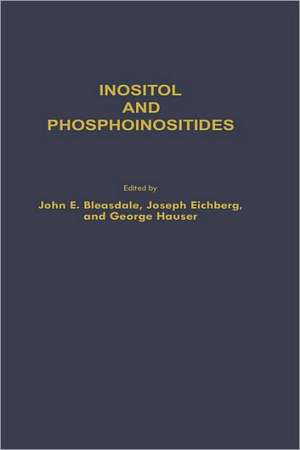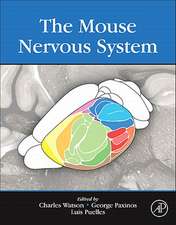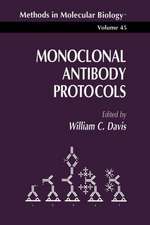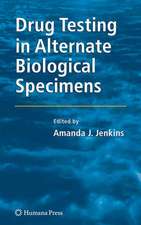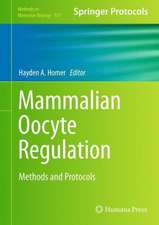Inositol and Phosphoinositides: Metabolism and Regulation: Experimental Biology and Medicine, cartea 6
Autor John E. Bleasdale, Joseph Eichberg, George Hauseen Limba Engleză Hardback – 20 mai 1985
| Toate formatele și edițiile | Preț | Express |
|---|---|---|
| Paperback (1) | 1230.04 lei 6-8 săpt. | |
| Humana Press Inc. – 5 oct 2011 | 1230.04 lei 6-8 săpt. | |
| Hardback (1) | 1240.93 lei 6-8 săpt. | |
| Humana Press Inc. – 20 mai 1985 | 1240.93 lei 6-8 săpt. |
Din seria Experimental Biology and Medicine
- 15%
 Preț: 654.77 lei
Preț: 654.77 lei - 5%
 Preț: 738.20 lei
Preț: 738.20 lei - 5%
 Preț: 1434.04 lei
Preț: 1434.04 lei - 5%
 Preț: 1430.35 lei
Preț: 1430.35 lei - 5%
 Preț: 727.24 lei
Preț: 727.24 lei - 18%
 Preț: 1242.21 lei
Preț: 1242.21 lei - 5%
 Preț: 1435.85 lei
Preț: 1435.85 lei - 18%
 Preț: 1225.28 lei
Preț: 1225.28 lei - 5%
 Preț: 719.59 lei
Preț: 719.59 lei - 5%
 Preț: 1422.67 lei
Preț: 1422.67 lei - 18%
 Preț: 1215.36 lei
Preț: 1215.36 lei - 18%
 Preț: 1239.67 lei
Preț: 1239.67 lei - 5%
 Preț: 1423.95 lei
Preț: 1423.95 lei - 18%
 Preț: 1222.49 lei
Preț: 1222.49 lei - 18%
 Preț: 1239.49 lei
Preț: 1239.49 lei - 5%
 Preț: 727.44 lei
Preț: 727.44 lei - 5%
 Preț: 1112.70 lei
Preț: 1112.70 lei - 5%
 Preț: 786.29 lei
Preț: 786.29 lei - 5%
 Preț: 1423.95 lei
Preț: 1423.95 lei - 5%
 Preț: 729.82 lei
Preț: 729.82 lei - 18%
 Preț: 959.19 lei
Preț: 959.19 lei - 18%
 Preț: 1236.51 lei
Preț: 1236.51 lei - 5%
 Preț: 1113.63 lei
Preț: 1113.63 lei - 15%
 Preț: 644.18 lei
Preț: 644.18 lei
Preț: 1240.93 lei
Preț vechi: 1513.33 lei
-18% Nou
Puncte Express: 1861
Preț estimativ în valută:
237.48€ • 257.87$ • 199.48£
237.48€ • 257.87$ • 199.48£
Carte tipărită la comandă
Livrare economică 22 aprilie-06 mai
Preluare comenzi: 021 569.72.76
Specificații
ISBN-13: 9780896030749
ISBN-10: 0896030741
Pagini: 698
Ilustrații: XXII, 698 p.
Dimensiuni: 152 x 229 x 41 mm
Greutate: 1.11 kg
Ediția:1985
Editura: Humana Press Inc.
Colecția Humana
Seria Experimental Biology and Medicine
Locul publicării:Totowa, NJ, United States
ISBN-10: 0896030741
Pagini: 698
Ilustrații: XXII, 698 p.
Dimensiuni: 152 x 229 x 41 mm
Greutate: 1.11 kg
Ediția:1985
Editura: Humana Press Inc.
Colecția Humana
Seria Experimental Biology and Medicine
Locul publicării:Totowa, NJ, United States
Public țintă
ResearchCuprins
I: myo-Inositol Metabolism and Homeostasis.- The Mechanism of Enzymatic Isomerization of Glucose 6-Phosphate to L-myo-Inositol 1-Phosphate.- Regulation of the Lipid Composition of Lung Surfactant.- Nutritional Regulation of the Composition, Metabolism, and Function of Cellular Phosphatidylinositol.- Detection of Receptor-Linked Phosphoinositide Metabolism in Brain of Lithium-Treated Rats.- Propranolol-Induced Membrane Perturbation and the Metabolism of Phosphoinositides and Arachidonoyl Diacylglycerols in the Retina.- Neurotransmitter Receptor-Mediated myo-Inositol 1-Phosphate Accumulation in Hippocampal Slices.- Early Events in the Selective Cytotoxicity to Tumor Cells Induced by Liposomes Containing Plant Phosphatidylinositol.- Discussion.- II: Phosphoinositide Biosynthesis and Degradation.- Phosphatidylinositol Synthase in Mammalian Pancreas.- The Enzymology of Phosphoinositide Catabolism, with Particular Reference to Phosphatidylinositol 4,5-Bisphosphate Phosphodiesterase.- Subcellular Sites of Polyphosphoinositide Metabolism in Rat Liver.- Loss of Phosphatidylinositol and Gain in Phosphatidate in Neutrophils Stimulated with FMet-Leu-Phe.- The De Novo Phospholipid Synthesis Effect: Occurrence, Characteristics, Underlying Mechanisms, and Functional Significance in Hormone Action and Secretion.- Hydrolysis of Phosphatidylinositol 4-Phosphate and Phosphatidylinositol(4,5)-Bisphosphate by Specific Phosphomonoesterases in Human Erythrocytes.- Drug-Induced Modifications of Phosphoinositide Metabolism.- Discussion.- III: Receptor-Mediated Alterations in Phosphoinositide Metabolism.- Inositol Lipid Breakdown in Receptor-Mediated Responses of Sympathetic Ganglia and Sympathetically Innervated Tissues.- Hormone Effects on Phosphoinositide Metabolism in Liver.- Relationship Between Vasopressin Activation of Rat Hepatocyte Glycogen Phosphorylase, Inhibition of Ca2+-Mg2+-ATPase, and Phosphoinositide Breakdown.- Polyphosphoinositides and Muscarinic Cholinergic and ?1-Adrenergic Receptors in the Iris Smooth Muscle.- The Phosphatidylinositol Effect in the Retina: Role of Light and Neurotransmitters.- Ca2+-Mobilizing Agonists Stimulate a Polyphosphoinositide-Specific Phospholipase C in Rat Parotid Gland.- Phosphatidylinositol Degradation is Directly Proportional to the Rate of Cell Division in Embryonic Chicken Lens Epithelia.- Discussion.- IV: Phosphoinositides, Calcium, and Protein Phosphorylation.- Messages of the Phosphoinositide Effect.- Inositol Trisphosphate and Calcium Mobilization.- Calcium-Phosphatidylinositol Interactions in Secretory Cells and the Role of Arachidonic Acid.- Calcium and Inositol Phospholipid Degradation in Signal Transduction.- The Role of Phosphoprotein B-50 in Phosphoinositide Metabolism in Brain Synaptic Plasma Membranes.- Purification of Protein Kinase C and Phorbol Ester Receptor Using Polyacrylamide-Immobilized Phosphatidylserine.- Second Messenger Role of Inositol Trisphosphate for Mobilization of Intracellular Calcium in Liver.- Discussion.- V: Phosphoinositides and Arachidonic Acid Mobilization.- Mechanisms for Eicosanoid Precursor Uptake and Release by a Tissue Culture Cell Line.- The Mobilization of Arachidonate and Metabolism of Phosphoinositides in Stimulated Human Platelets.- The Relevance of Inositide Degradation and Protein Kinase C in Platelet Responses.- Regulation of Arachidonic Acid Release for Prostaglandin Production During Parturition.- Is Phosphatidylinositol Involved in the Release of Free Fatty Acids in Cerebral Ischemia?.- Endogenous Phospholipid Metabolism in Stimulated Human Platelets: ALink Between Inositide Breakdown and Calcium Mobilization.- Phosphatidylinositol Turnover in Madin-Darby Canine Kidney Cells: Comparison of Stimulation by A23187 and 12-O-Tetradecanoyl-Phorbol-13-Acetate.- Discussion.- VI: Phosphoinositide Metabolism in the Nervous System.- Inositol, Sorbitol, and Diabetic Neuropathy.- Altered Nerve myo-lnositol Metabolism in Experimental Diabetes and Its Relationship to Nerve Function.- Changes in Peripheral Nerve Polyphosphoinositide Metabolism in Experimental Diabetes: Nature and Significance.- Relationship of Inositol, Phosphatidylinositol, and Phosphatidic Acid in CNS Nerve Endings.- Polyphosphoinositide Turnover in the Nervous System.- Metabolism of Inositol-Containing Phospholipids in the Superior Cervical Ganglion of the Rat.- Discussion.- Concluding Remarks—A Bright Future.- Abstracts.- Index of Abstract Authors.
